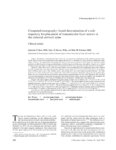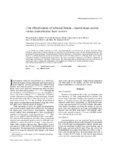Filters: Department: "Neurosurgery" Collection: "ir_uspace" School Or College: "School of Medicine" Format: "application/pdf"
| Creator | Title | Description | Subject | Date | ||
|---|---|---|---|---|---|---|
| 26 |
 |
Schmidt, Meic H.; Apfelbaum, Ronald I. | Chylorrhea: a rare complication of thoracoscopic discectomy of the thoracolumbar junction | The thoracic duct along with the cisterna chyli is a major lymphatic pathway near the anterior thoracolumbar spine. Despite the fragile nature of the lymphatic system and its proximity to the spinal column, chylorrhea is rarely encountered by spine surgeons. The authors present a unique case of chyl... | Chylous leak; Thoracoscopy; Thoracic spine; Thoracoscopic discectomy; Thoracolumbar junction; Chylorrhea | 2007 |
| 27 |
 |
Couldwell, William T. | Clinical and radiographic response in a minority of patients with recurrent malignant gliomas treated with high-dose tamoxifen | PREVIOUS WORK HAS demonstrated the importance of the Protein Kinase C (PKC) signal transduction system in regulating the growth rate of malignant gliomas in vitro. Tamoxifen inhibits PKC in a minority of malignant gliomas within the micromolar concentration range in vitro, a property distinct from... | Tamoxifen; Protein kinase C; Glioma; Brain neoplasm; Chemotherapy; Glioma | 1993 |
| 28 |
 |
Couldwell, William T. | Combined transmastoid retro- and infralabyrinthine transjugular transcondylar transtubercular high cervical approach for resection of glomus jugulare tumors | COMPLEX TUMORS OF the glomus jugulare present a surgical challenge because of their difficult location, extreme vascularity, and involvement with multiple cranial nerves. Modern microneurosurgical and cranial base techniques have enabled safe total removal of these complicated tumors. We describe a ... | Cranial base approach; Surgical approach; Glomus jugulare tumor; Jugular foramen exposure; Microsurgical anatomy | 2006 |
| 29 |
 |
Couldwell, William T. | Comment on Aydin, K., et al: Localization of cerebrospinal fliud leaks by gadolinium-enhanced magnetic resonance cisternography: a 5-year single-center experience | The Author's describe the use of intrathecal Gd-enhanced MR cisternography for the definition of cerebrospinal fluid leaks in 51 patients. They were able to identify the site of leak in 43 of 51 patients (84%). Although the technique is not new, most of the previous articles are found in the neuror... | Cerebrospinal fluid leaks | 2007 |
| 30 |
 |
Couldwell, William T. | Comment on Kitano, M. and Taneda, M.: Extended transsphenoidal approach to the anterior communicating artery aneurysm: aneurysm incidentally identified during macroadenoma resection | Kitano and Taneda describe the successful clipping of an ACoA aneurysm via the transsphenoidal approach. There are limitations of the approach; most notable are the limited and narrow corridor and the relationship between the aneurysm and the optic chiasm, which may hinder full visualization of the ... | Aneurysm; Transsphenoidal approach | 2007 |
| 31 |
 |
Couldwell, William T. | Comment on Kitano, M., et al.: Subdural patch graft technique for watertight closure of large dural defects in extended transsphenoidal surgery | Ahn and Kim demonstrate a suturing technique to close dural defects after transsphenoidal and extended transsphenoidal approaches. The technique entails a specifically designed forceps to cinch the knot down in the depths of the field. The Author's used the technique in 21 consecutive patients (16 e... | Transsphenoidal surgery; CSF leaks | 2009 |
| 32 |
 |
Couldwell, William T. | Comment on Nugent, G. R.: Targeting the ventral lateral nucleus of the thalamus: a stereotactic vignette | Dr. Nugent provides a fascinating personal account of his early experience with stereotactic surgery for movement disorders. I was especially pleased to read the positive comments regarding the personal interactions with and innovations of Irving Cooper, a neurosurgeon who was derided by his peers b... | Stereotactic surgery; Stereotaxis | 2006 |
| 33 |
 |
Couldwell, William T. | Comment on Wong, H. T., et al.: Comparative impact of video consultation on emergency neurosurgical referrals | The Author's explored the facility and accuracy of telephone, teleradiology, or video consultation between a large general hospital and their tertiary neurosurgical center. Although there was increased diagnostic accuracy with video consultation or teleradiology, they note that consultation via vid... | Teleradiology; Video consultation; Neurosurgical referrals | 2006 |
| 34 |
 |
Couldwell, William T. | Comment on: Chronic brain inflammation and persistent herpes simplex virus 1 thymidine kinase expression in survivors of syngeneic glioma treated by adenovirus-mediated gene therapy: implications for clinical trials | The long-term consequences of adenovirus-mediated conditional cytotoxic gene therapy for gliomas remain uncharacterized. We report here detection of active brain inflammation 3 months after successful inhibition of syngeneic glioma growth. The inflammatory infiltrate consisted of activated macrophag... | Brain inflammation; Herpes simplex virus-1; Thymidine kinase; Syngeneic glioma; Adenovirus-mediated gene therapy | 1994 |
| 35 |
 |
Couldwell, William T. | Communication between malignant glioma cells and vascular endothelial cells through gap junctions | Object. Extensive invasion and angiogenesis are hallmark features of malignant gliomas. Communication between malignant glioma cells and surrounding astrocytes occurs, resulting in transformation of the astrocytic phenotype. In the present study, the authors examined whether malignant glioma cells a... | 2003-01-01 | |
| 36 |
 |
Kestle, John R. W. | Comparison between magnetic resonance imaging and computed tomography for stereotactic coordinate determination | The spatial accuracy of magnetic resonance imaging (MRI) has not been established for stereotactic surgery. Magnetic susceptibility artifacts may lead to anatomical distortion and inaccurate stereotactic MRI coordinates, especially when targets are in regions of the brain out of the center of the ma... | Computed tomography; Stereotactic coordinates; Stereotactic surgery | 1992 |
| 37 |
 |
Dailey, Andrew T.; Brodke, Darrel S. | Comparison of computerized tomography and direct visualization in thoracic pedicle screw placement | Object. To validate computerized tomography (CT) scanning as a tool to assess the accuracy of thoracic pedicle screw placement, the authors compared its accuracy with that of direct visualization in instrumented cadaveric spine specimens. Methods. A grading scale was devised to score the placement... | Computerized tomography; Direct visualization; Thoracic pedicle screw; Pedicle; Thoracic spine | 2002 |
| 38 |
 |
Gottfried, Oren N.; Liu, James K.; Couldwell, William T. | Comparison of radiosurgery and conventional surgery for the treatment of Glomus Jugulare tumors | Objective: The optimal management of glomus jugulare tumors remains controversial. Available treatments were once associated with poor outcomes and significant complication rates. Advances in skull base surgery and the delivery of radiation therapy by stereotactic radiosurgery have improved the resu... | Glomus Jugulare; Radiosurgery; Radiotherapy; Skull Base; Surgery | 2004-07-07 |
| 39 |
 |
Couldwell, William T. | Comparison of radiosurgery and conventional surgery for the treatment of glomus jugulare tumors | Object. The optimal management of glomus jugulare tumors remains controversial. Available treatments were once associated with poor outcomes and significant complication rates. Advances in skull base surgery and the delivery of radiation therapy by stereotactic radiosurgery have improved the results... | 2004 | |
| 40 |
 |
Couldwell, William T.; Gillespie, David L.; Jensen, Randy L. | Comparison of the cell lines used in meningoma research | Background: Immortal cell lines and cell lines derived from operative specimens transplanted into animal models are used in meningioma research. We address two criticisms of the mouse xenograft flank tumor model: Why are tumor induction rates derived from operative specimens low and inconsistent? Ar... | CH-157 MN; IOMM-Lee; Meningioma; Xenograft Mouse Model; Flank tumors | 2008 |
| 41 |
 |
Dailey, Andrew T. | Complement depletion reduces macrophage infiltration and activation during Wallerian degeneration and axonal regeneration | After peripheral nerve injury, macrophages infiltrate the degenerating nerve and participate in the removal of myelin and axonal debris, in Schwann cell proliferation, and in axonal regeneration. In vitro studies have demonstrated the role serum complement plays in both macrophage invasion and activ... | 1998 | |
| 42 |
 |
Kestle, John R. W.; Brockmeyer, Douglas Lee | Complications of intracranial pressure monitoring in children with head trauma | Object. Intracranial pressure (ICP) monitoring has become routine in the management of patients with traumatic brain injury (TBI). Many surgeons prefer to use external ventricular drains (EVDs) over fiberoptic monitors to measure ICP because of the added benefit of cerebrospinal fluid drainage. The ... | Head trauma; Ventriculostomy; External ventricular drain; Monitoring; Fiberoptic monitor | 2004 |
| 43 |
 |
Digre, Kathleen B.; Schmidt, Richard H.; Osborne, Anne G.; Patel, Bhupendra C.; Pratt, David; Rietz, Lisa A. | Compressive optic neuropathy caused by renal osteodystrophy. Case report. | Compressive optic neuropathy with acute or chronic vision loss has been associated with various skull base tumors, aneurysms, Graves disease, trauma, and, less commonly, fibrous dysplasia and osteopetrosis. The Author's present a case of acute visual deterioration in a 25-year-old woman who had mass... | Optic Neuropathy; Optic Nerve Decompression; Renal Osteodystrophy | 2001-10 |
| 44 |
 |
Bisson, Erica F. | Computed tomography-based determination of a safe trajectory for placement of transarticular facet screws in the subaxial cervical spine: Clinical article | Object. Placement of transarticular facet screws is one option for stabilization of the subaxial cervical spine. Small clinical series and biomechanical data support their role as a substitute for other posterior stabilization techniques; however, the application of transarticular facet screws in th... | 2012-01-01 | |
| 45 |
 |
Couldwell, William T. | Conflict and opportunity: neurosurgery and industry | The relationship between neurosurgery and industry is multifaceted. Most aspects of this relationship promote the advancement of a highly technical field such as neurosurgery, helping neurosurgeons bring ever more effective therapies to their patients. However, serious ethical and legal concerns a... | 2007-01-01 | |
| 46 |
 |
Couldwell, William T. | Cosmetic mastoidectomy for the combined supra/infratentorial transtemporal approach | The authors describe a cosmetic mastoidectomy technique for use when performing a combined supra/ infratentorial craniotomy and transtemporal exposure. The technique involves a single temporal suboccipital bone flap and cosmetic mastoidectomy, removing the outer table of bone for later replacement... | Surgical approach; Supratentorial approach; Infratentorial approach; Petroclival meningiomas | 1993 |
| 47 |
 |
Bisson, Erica F. | Cost effectiveness of subaxial fusion-lateral mass screws versus transarticular facet screws | As health care reform continues to evolve, demonstrating the cost effectiveness of spinal fusion procedures will be of critical value. Posterior subaxial cervical fusion with lateral mass screw and rod instrumentation is a wellestablished fixation technique. Subaxial transarticular facet fixation is... | 2012-01-01 | |
| 48 |
 |
Kestle, John R. W. | Cost-effectiveness analysis of endoscopic third ventriculostomy | OBJECTIVE: Endoscopic third ventriculostomy (ETV) is currently the principal alternative to cerebrospinal fluid shunt placement in the management of pediatric hydrocephalus. Cost-effectiveness analysis can help determine the optimal strategy for integrating these different approaches. METHODS: All... | Endoscopic third ventriculostomy; ETV | 2002 |
| 49 |
 |
Kestle, John R. W.; Brockmeyer, Douglas Lee | Cranial base strategies for resection of craniopharyngioma in children | The optimal treatment of craniopharyngioma in children remains a challenge. The use of complete excision to minimize recurrence continues to be controversial because of the risk of postoperative morbidity and death. Advances in skull base approaches, modern microsurgical techniques, neuroimaging, an... | Craniopharyngioma; Surgical approach; Skull base surgery | 2005 |
| 50 |
 |
Couldwell, William T. | Cranioplasty with the Medpor porous polyethylene Flexblock implant | The authors describe the use of a porous polyethylene Flexblock implant for cosmetic cranioplasty. The implant may be used to cover any small- or medium-sized (< 8 cm) cranial defect, offering similar cosmetic results to standard alloplast cranioplasty while decreasing operation time. The porous i... | Cranioplasty; Medpor; Alloplast; Polyethylene; Skull defect | 1994 |
